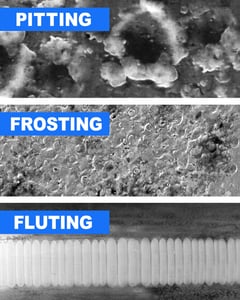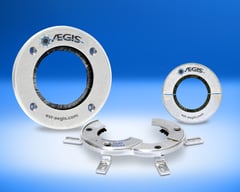More and more electric motors are being controlled by variable frequency drives (VFDs). VFDs offer many advantages over across-the-line power. Depending on the application, these include
- Reduced inrush current
- Smooth acceleration & deceleration
- Precise speed control
- Adjustable speed and torque
- Reduced need for power transmission equipment (e.g., gearboxes)
- Large energy savings
But drives have their drawbacks, too. Among other things,  VFD power produces stray currents that cause electrical bearing damage. The damage starts as microscopic pits in the bearing race walls from electrical arcing. Over time, pitting accumulates until the races are “frosted,” and no longer smooth. They eventually develop a ridged pattern called fluting.
VFD power produces stray currents that cause electrical bearing damage. The damage starts as microscopic pits in the bearing race walls from electrical arcing. Over time, pitting accumulates until the races are “frosted,” and no longer smooth. They eventually develop a ridged pattern called fluting.
By the time a bearing is fluted, failure is imminent, and production must shut down while the motor is repaired or replaced.
There are three types VFD-induced bearing current, and they affect motors of different sizes and in different situations:
- Shaft voltage discharge occurs when the VFD’s output creates a voltage difference between the motor’s rotor and frame. The voltage builds up until it arcs through the bearing. This type of bearing current affects all motors on drives, regardless of size.
- High frequency circulating currents are caused by high frequency magnetic flux inside the motor. They circulate from frame to shaft, through both bearings. These are a problem for ac motors over 100 hp (75 kW) and dc motors over 10 hp (7.5 kW).
- Rotor ground currents occur when there is no low-impedance path from the motor frame back to the VFD. Seeking a low-resistance path, current leaves the frame by arcing through the bearings, moves down the motor shaft into the driven equipment, and then makes its way back to the VFD.
Fortunately, there are solutions to all of these problems:
- Shaft voltage discharge currents can be diverted away from the bearings with an AEGIS® Shaft Grounding Ring. AEGIS rings provide a path of least resistance between the motor shaft and frame, so current travels through the ring instead of through the bearings. Small motors require one AEGIS SGR ring. For ac motors over 600 V or 500 hp (375 kW), and dc motors over 300 hp (225 kW), the larger AEGIS PRO Ring is recommended.
Because shaft voltage discharge is a problem in all motors on VFDs, AEGIS rings are also necessary in the following cases:
- For ac motors over 100 hp and dc motors over 10 hp, using one hybrid, ceramic, or insulated bearing will interrupt circulating currents.
- Rotor ground currents can be dealt with by using special shielded VFD cable or by bonding the motor to the drive and/or its driven equipment with high frequency grounding straps.
AEGIS Rings also come with a 2-year extended warranty against bearing fluting damage. No other form of protection against VFD-caused bearing damage offers a warranty like this.

To learn more about AEGIS shaft grounding and best practices for electrical bearing protection, sign up for a training. We offer monthly live training webinars, and - pandemic restrictions permitting - we can also visit your facility to review your exact application.


